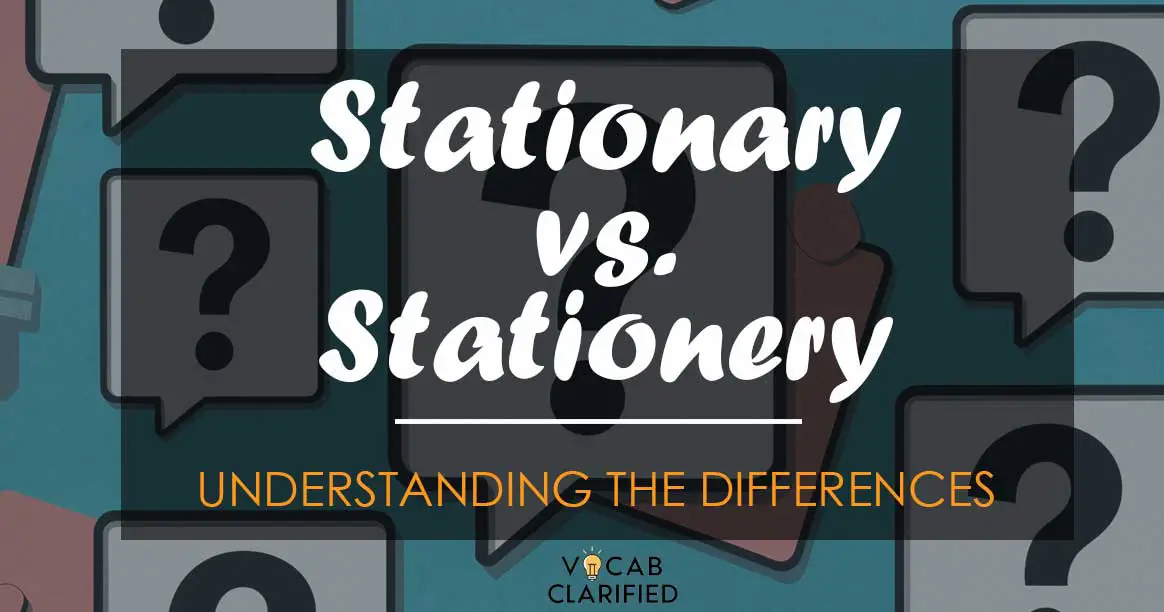Ever found yourself hesitating at the office supplies store, unsure whether to purchase “stationary” or “stationery” items? If so, you are not alone.
This article aims to dissolve the fog surrounding these two similar-sounding but distinct terms, guiding you to a clearer understanding and more confident usage.
Understanding Stationary and Stationery
Stationary: Definition and Usage
“Stationary” is typically used in contexts relating to immobility or lack of movement. It means not moving or not intended to be moved.
For example:
- “The car remained stationary despite the heavy traffic.”
- “He stood stationary at the entrance, waiting for his friend.”
Stationery: Definition and Usage
Contrastingly, “stationery” refers to writing materials and office supplies, such as paper, pens, envelopes, and other related items.
For instance:
- “She bought new stationery for the upcoming school year.”
- “The office manager ordered more stationery to restock the supply cabinet.”
Side-by-Side Comparison
To further clarify the differences and help you decide which to use, here is a side-by-side comparison:
| Aspect | Stationary | Stationery |
| Definition | Not moving or not intended to be moved | Writing materials and office supplies |
| Common Usage | “The car remained stationary.” | “She bought new stationery.” |
| Key Differences | Describes immobility | Refers to items used for writing and office work |
When deciding between “stationary” and “stationery,” consider the context. If you are referring to something that is not moving, “stationary” is the correct term.
However, if you are talking about writing materials or office supplies, “stationery” is the appropriate choice. Remember, the best choice often depends on the specific context of your sentence.
Everyday Usage Examples
Let’s see some more examples to illustrate how “stationary” and “stationery” fit into everyday language:
- Stationary:
- “During the earthquake drill, everyone was instructed to remain stationary under their desks.”
- “The stationary bike in the gym is perfect for cardio workouts without going anywhere.”
- Stationery:
- “For her birthday, she received a beautiful set of personalized stationery.”
- “Teachers often spend their own money on classroom stationery.”
FAQ: Stationary vs. Stationery
The main difference lies in their meanings and usage. “Stationary” refers to something that is not moving or not intended to be moved, whereas “stationery” pertains to writing materials and office supplies, such as paper, pens, and envelopes.
No, “stationary” and “stationery” cannot be used interchangeably. “Stationary” describes immobility, while “stationery” refers to items used for writing and office work. Using one in place of the other would result in incorrect and confusing sentences.
A useful mnemonic is to remember that “stationery” contains an “e,” just like “envelope,” which is a common item of stationery. This can help you recall that “stationery” refers to writing materials, while “stationary” is related to immobility.
Yes, “stationary” is often used in contexts related to objects or people that are not moving, such as “stationary bike” or “remain stationary.” “Stationery” is frequently used when discussing supplies for writing or office tasks, such as “stationery set” or “buying stationery.”
Conclusion
Understanding the difference between “stationary” and “stationery” can save you from common writing errors and confusion. “Stationary” refers to immobility, while “stationery” refers to writing materials and office supplies.
By remembering these definitions and their contexts, you’ll be able to use these terms correctly and confidently in your writing.

